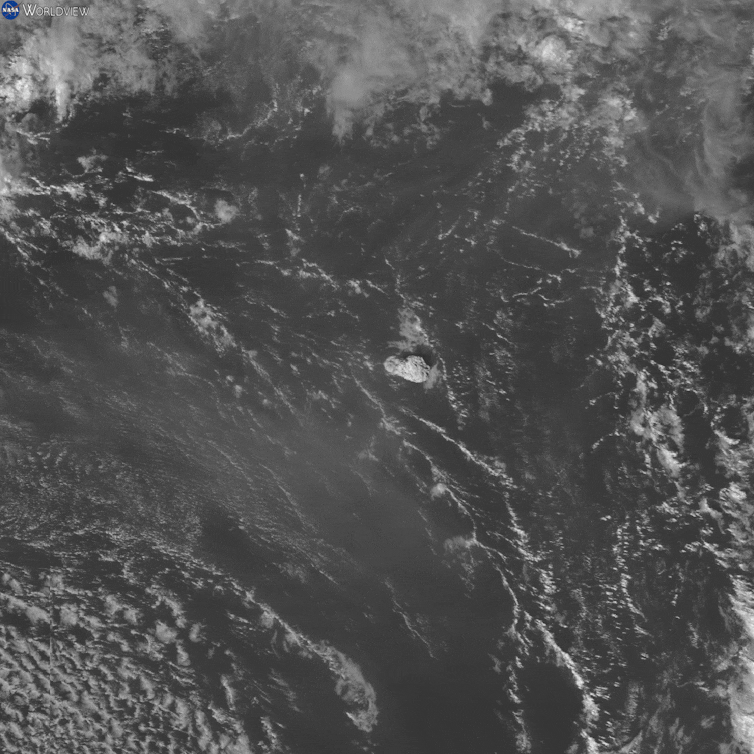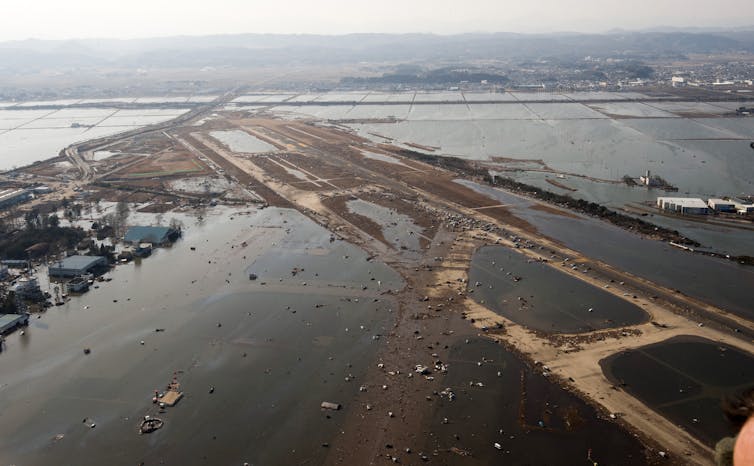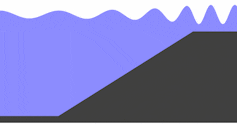
Sally Warner, Brandeis University
On Jan. 15, 2022, the Hunga Tonga-Hunga Ha’apai volcano in Tonga erupted, sending a tsunami racing across the Pacific Ocean in all directions.
As word of the eruption spread, government agencies on surrounding islands and in places as far away as New Zealand, Japan and even the U.S. West Coast issued tsunami warnings. Only about 12 hours after the initial eruption, tsunami waves a few feet tall hit California shorelines – more than 5,000 miles away from the eruption.
I’m a physical oceanographer who studies waves and turbulent mixing in the ocean. Tsunamis are one of my favorite topics to teach my students because the physics of how they move through oceans is so simple and elegant.
Waves that are a few feet tall hitting a beach in California might not sound like the destructive waves the term calls to mind, nor what you see in footage of tragic tsunamis from the past. But tsunamis are not normal waves, no matter the size. So how are tsunamis different from other ocean waves? What generates them? How do they travel so fast? And why are they so destructive?

Deep displacement
Most waves are generated by wind as it blows over the ocean’s surface, transferring energy to and displacing the water. This process creates the waves you see at the beach every day.
Tsunamis are created by an entirely different mechanism. When an underwater earthquake, volcanic eruption or landslide displaces a large amount of water, that energy has to go somewhere – so it generates a series of waves. Unlike wind-driven waves where the energy is confined to the upper layer of the ocean, the energy in a series of tsunami waves extends throughout the entire depth of the ocean. Additionally, a lot more water is displaced than in a wind-driven wave.
Imagine the difference in the waves that are created if you were to blow on the surface of a swimming pool compared to the waves that are created when someone jumps in with a big cannonball dive. The cannonball dive displaces a lot more water than blowing on the surface, so it creates a much bigger set of waves.
Earthquakes can easily move huge amounts of water and cause dangerous tsunamis. Same with large undersea landslides. In the case of the Tonga tsunami, the massive explosion of the volcano displaced the water. Some scientists are speculating that the eruption also caused an undersea landslide that contributed to the large amount of displaced water. Future research will help confirm whether this is true or not.
Tsunami waves travel fast
No matter the cause of a tsunami, after the water is displaced, waves propagate outward in all directions – similarly to when a stone is thrown into a serene pond.
Because the energy in tsunami waves reaches all the way to the bottom of the ocean, the depth of the sea floor is the primary factor that determines how fast they move. Calculating the speed of a tsunami is actually quite simple. You just multiply the depth of the ocean – 13,000 feet (4,000 meters) on average – by gravity and take the square root. Doing this, you get an average speed of about 440 miles per hour (700 kilometers per hour). This is much faster than the speed of typical waves, which can range from about 10 to 30 mph (15 to 50 kph).
This equation is what oceanographers use to estimate when a tsunami will reach faraway shores. The tsunami on Jan. 15 hit Santa Cruz, California, 12 hours and 12 minutes after the initial eruption in Tonga. Santa Cruz is 5,280 miles (8,528 kilometers) from Tonga, which means that the tsunami traveled at 433 mph (697 kph) – nearly identical to the speed estimate calculated using the ocean’s average depth.

Destruction on land
Tsunamis are rare compared to ubiquitous wind-driven waves, but they are often much more destructive. The 2004 Indian Ocean tsunami killed 225,000 people. More than 20,000 lost their lives in the 2011 Japan tsunami.
What makes tsunamis so much more destructive than normal waves?

In the open ocean, tsunami waves can be small and may even be undetectable by a boat at the surface. But as the tsunami approaches land, the ocean gets progressively shallower and all the wave energy that extended thousands of feet to the bottom of the deep ocean gets compressed. The displaced water needs to go somewhere. The only place to go is up, so the waves get taller and taller as they approach shore.
When tsunamis get to shore, they often do not crest and break like a typical ocean wave. Instead, they are more like a large wall of water that can inundate land near the coast. It is as if sea level were to suddenly rise by a few feet or more. This can cause flooding and very strong currents that can easily sweep people, cars and buildings away.
[Get fascinating science, health and technology news. Sign up for The Conversation’s weekly science newsletter.]
Luckily, tsunamis are rare and not nearly as much of a surprise as they once were. There is now an extensive array of bottom pressure sensors, called DART buoys, that can sense a tsunami wave and allow government agencies to send warnings prior to the arrival of the tsunami.
If you live near a coast – especially on the Pacific Ocean where the vast majority of tsunamis occur – be sure to know your tsunami escape route for getting to higher ground, and listen to tsunami warnings if you receive one.
The eruption of the Hunga Tonga-Hunga Ha’apai volcano severed the main communication cable that connects the people of Tonga to the rest of the world. While the science of tsunamis can be fascinating, these are serious natural disasters. Only a few deaths have been reported so far from Tonga, but many people are missing and the true extent of the damage from the tsunami is still unknown.![]()
Sally Warner, Assistant Professor of Climate Science, Brandeis University
This article is republished from The Conversation under a Creative Commons license. Read the original article.
The views and opinions expressed in the article are solely those of their authors, and do not necessarily reflect the opinions and beliefs of WomenInScience.com.